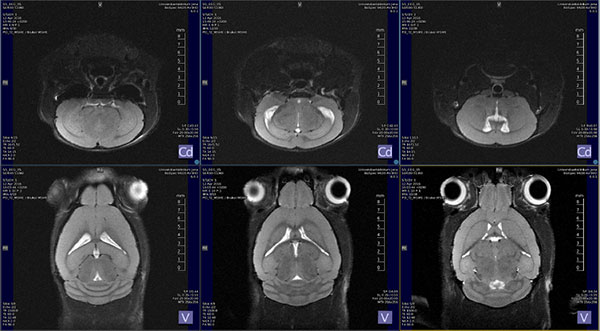Curved, Open-loop, Detunable 1H Surface Coil
A Doty curved, open-loop, detunable 1H surface coil has been optimized for sensitivity and best filling factor for small animal brain. This is a convenient coil that enables simultaneous integration of fMRI with EEG or SEP. See results at 400 MHz for mouse brain, from the laboratory of Jürgen Reichenbach, Friedrich-Schiller University, Jena, Germany.
It is often desirable to integrate electroencepha-logram (EEG) or stimulation evoked potential (SEP) to assess the different time scales of the modalities during functional MRI (fMRI). In conjunction with researchers at the Univ. of Jena 1,2 a curved, open loop surface coil (400 MHz 1H) with active detuning capability was designed to fit tightly around a mouse head (Fig. 1), and permit an electrode to protrude through the coil center. An adapted mounting block (Fig. 2) designed at Univ. Jena, was used to place the coil into direct contact around the mouse head.

Figure 1. Placement of the Doty surface coil on mouse head. The coil wire surrounds the head, with open center to provide free access to ~18 x 14 mm area of the cortex.
Coil Specifications:
The DOTY loop coil is 20 mm long x 16 mm wide, with a left-right curvature of radius 9 mm, approximate surface area of 18mm X 14mm, to fit it perfectly to an adult c57BL/6J mouse. The coil is operated as actively de-tunable receive only coil, and was used in conjunction with a volume transmit coil.

Figure 2. Doty surface coil on top of a custom mounting block (shown on left), placed into a standard Bruker mouse bed base and tip.
The Advantages:
(1) fMRI alone or with simultaneous EEG or SEP; (2) Open loop design provides unhindered access to most of the cortical surface, allowing placement of EEG electrodes; (3) Relatively higher SNR from deep brain areas like the hippocampus, due to the fact that the loop is bent around the head. At a depth of 7.27 mm, the SNR is 25% higher with the Doty curved surface coil compared to a Bruker 4 channel array coil for mouse head (K-H Herrmann, et.al, abstract submitted to German chapter of ISMRM 2016 in Würzburg). (4) The curved coil can also be customized for other nuclei as well for future applications; for example 1H/19F MRI for in vivo cell tracking, 13C or 31P MRI for brain metabolism.

Figure 3 Representative T2 weighted mouse brain images acquired with DOTY 400 MHz 1H Rx surface coil on a 9.4 Tesla Bruker BioSpec small animal MR system (Bruker BioSpin MRI, Ettlingen, Germany). The right hand scale is for visual measurement of signal change as a function of distance below the surface coil loop.

Figure 4 T2 weighted images with important targets for deep brain fMRI study highlighted by color: yellow=hippocampus; green= thalamus; orange=basal ganglia.’

Figure 5 Representative proton density weighted mouse brain images acquired with DOTY 400 MHz 1H Rx surface coil.
Doty Scientific would like to thank the following researchers for sharing their results:
Herrmann K-H1*, Minne J 1, 2, Reichenbach JR1
1Medical Physics Group, IDIR, University Hospital Jena – Friedrich-Schiller University, Jena, Germany.
2University of Applied Sciences “Ernst Abbe”, Dept. of Medical Technology and Biotechnology, Jena, Germany.
*Corresponding author.

